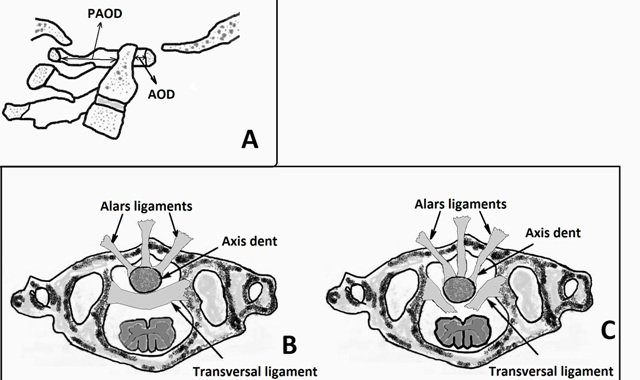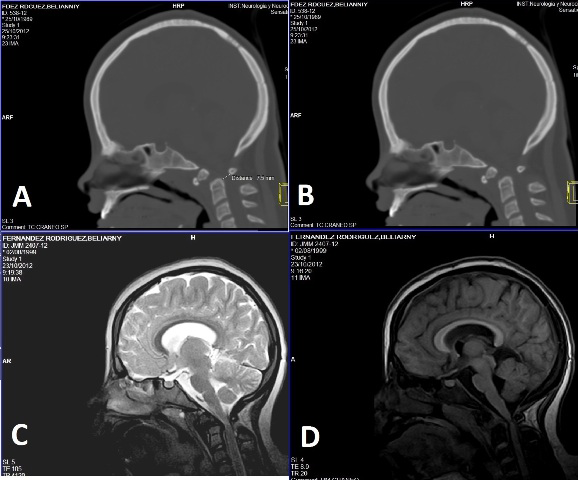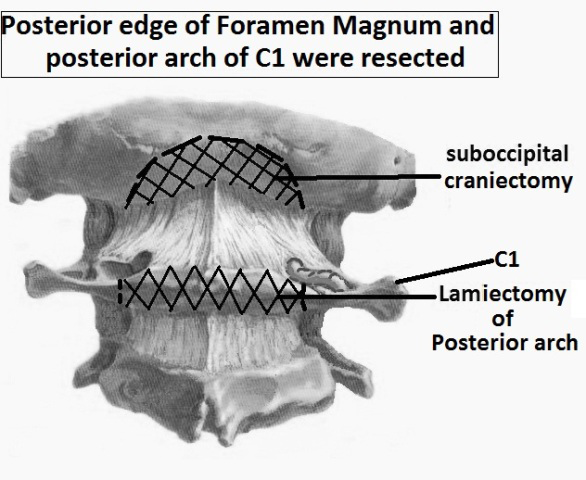Journal of
eISSN: 2373-6410


Case Report Volume 5 Issue 2
1Assistant professor, Miguel Enriquez Hospital, Cuba
2Calixto Garcia Hospital, Cuba
Correspondence: Reinel A Junco Martin, Neurosurgeon, Assistant professor, Miguel Enriquez Hospital, Cuba,
Received: June 29, 2016 | Published: October 20, 2016
Citation: Martin RAJ, Fabre DCER (2016) Occipito-Cervical Instability in Down’s Syndrome. Case Report. J Neurol Stroke 5(2): 00169. DOI: 10.15406/jnsk.2016.05.00169
The atlanto-axial instability account 10-20% of Down’s syndrome (DS) patients. This condition is commonly asymptomatic and its diagnosis is base on radiographic finding, where we can observe an anterior increase of atlanto-axial distance. Symptomatic atloanto-axial instability (AAI) affects 1-2% of DS patients, showing sign and symptoms of spinal cord compression.
Cervical spondylosis is frequent in DS patient also they have most probability of suffer spinal cord injury.1 Our case report is a 13 years old girl, who was send our hospital because she suffered gait difficult as consequence of muscle weak on her right arm and leg, on the physical exam we found right hyperreflexia and hemiparesia. CT-scan showed an occipito-cervical instability with platibasia and Os odontoidium. She was treated with screw and plate occipito-cervical artrodexis and opens of posterior edge of foramen magnum and dissects of posterior arch of C1.
Postsurgical evolution was satisfactory and she achieved improve her initial signs and symptoms.
The atlanto-axial instability is an increase of mobility of C2 respected to C1, it is more frequent in Down’s syndrome patients than in general population.2 This association was first reported in 19613 almost 100 years after Down syndrome was described. Although several cases of Atlanto-Axial Instability (AAI) were reported, only in 1983 through Paralympics games for Down syndrome players how suffered AAI was forbidden sports which required cervical spine effort.4
The atlanto-axial instability account 10-20% of Down´s syndrome patients. This condition is commonly asymptomatic and its diagnosis is base on lateral cervical spine radiography, where it can be observed an anterior increase of atlanto-axial distance (AAD).5- 8 Superior limit of normal AAD is 4 mm in patients under 15 years old and 3 mm in patients over this age7,9-11(Figure 1A). Anterior space between atlas and axis is open normally in flexion and closed in extension as consequence AOD is higher in flexion than in neutral or extension position.2
In DS there are 1-2% of probability to AAI convey in a symptomatic illness when odontoid process compresses spinal cord.12 The principal symptoms include cervical cramps, abnormal gait, sphincters control changes, signs of lesion in 1st motor neurons, paralysis and it could finish in death. More than 80% of symptomatic patient this is final results of gradual chronic instability.12 The rest of patients who may be have a previous normal radiologic, instability can be result of trauma, sport injury, endotraqueal intubation or head or cervical surgery.13,14 Patients who suffer AAI need an urgent evaluation and manage. Symptomatic patients need to take precaution to avoid cervical injury as a regular follow to find any neurologic deterioration.15
In 1966, Martel described degenerative change on cervical spine in DS patients. As consequence of this condition, degenerative changes are more frequent when patients increase their age.7,10,16
Although cervical spondylosis has potential to cause injury on spinal cord, it had received less attention than AAI. Due to studies about spinal abnormalities are based on pediatric population.1
Atlanto-axial join is extremely mobile but it is structurally weak and is located between two relative fixed points, atlanto-occipital and C2-C3 joints. This structure allows 50% of normal rotation in cervical spine but only 10° of flexion and extension.13 Atlanto-axial join is supported by two alar ligaments and one transverse ligament which keep odontoid process near to anterior arch of atlas (Figure 1A & B).
Atlanto-axial instability is cause primarily as consequence of transversal atlantal ligament laxity. This is part of general ligamentous laxity, characterizing DS patients. It occasionally results in hyper flexibility of all body joints.17,18 Also it can be found C1-C2 region abnormalities which are frequent in this patients and it can be part of AAI.19
High respiratory illness, frequently affect DS patients and it can cause retropharyngeal ligamentary laxity, when anterior arch of C1 is only few millimeters of pharynges.13 Cervical spondylosis prevalence is about 5% on fourth decade of live in normal patients and it increases to 25% on fifth decade of live.20 It is less frequent in pediatric patients even in DS patients.2 Early spondylosis can be a manifestation of early aging in DS patients which could also be an early beginning of dementia state. C5-C6 are intervertebral spaces more affected, follow by C4-C5, C6-C7, C3-C4 y C2-C3.2 This preference on inferior cervical vertebras is a similar patron found in general population.20
Our case report is a 13 years old girl, she suffered of Down syndrome, who was send our hospital because four months previously she suffered gait difficult as consequence of weak muscle on her right arm and leg, on the physical exam we found right hyperreflexia and hemiparesia. CT-scan showed an occipito-cervical instability with platibasia and Os odontoidium (Figure 2A & 2B). IRM confirmed her diagnosis where we can observe spinal cord compression and AAI (Figure 2C & 2D). On surgical treatment she was approached with screw and plate occipito-cervical artrodexis (Roy-Camille technique) the posterior edge of foramen magnum and the posterior arch of C1 were dissected (Figure 3). This opening of foramen magnum and posterior arch of C1 is useful to ovoid a feared complication known as respiratory arrest.

Figure 1 A Esquematic representation of normal atlanto-axial joint showing skull base, first, second and third cervical vertebras and atlanto-odontoidea distance (AOD) and posterior atlanto-odontoidea distance (DAOP). B: Esquematic representation of atloaxial ligaments overlay its internal joint and its relations with axis dent. C: Esquematic representation of tranversal ligament rupture and compressive effect of axis dent over spinal cord.

Figure 2 A,B CT-scan of Cervical spine where it can be seen a malformation of skull base (platibasia) with atlanto-axial instability. Observe spinal canal reduced also an Os odontoidium. C,D: IRM of Cervical spine shows C1-C2 luxation and spinal cord compression and anterior angulation.

Figure 3 Shows limits of resection for posterior edge of Foramen Magnum and posterior arch of C1, previously to occipito-cervical artrodexis.
We took transurgical and postsurgical radiography where we could see lateral Craneo-spinal joint radiography after traction with 2 kg of weight and how odontoid process returned to normal position (Figure 4A). On postsurgical lateral radiography it can be observed plate and screws fixing occipito-cervical joint (Roy Camille technique) (Figure 4B & 4C). Postsurgical evolution was satisfactory (Figure 5) and she achieved improve her initial signs and symptoms and she achieved improve her motor weakness (Figure 6).

Figure 4 Shows transurgical and postsurgical radiography.
A: Transurgical lateral Craneospinal joint radiography after traction with 5 kg of weight, notice how odontoideal process returned to normal position. B,C: Postsurgical lateral an posterior-anterior Craneospinal joint radiography where it can be shown plate and screws fixing occipitocervical joint (Roy Camille technique).
Our case report was about a Down syndrome teenager who suffered occipito-cervical instability because in this illness there are many anomalies among we can find ligamentary laxity, cranio-vertebral anomalies, and skull base malformations. On surgical treatment she was approached with screw and plate occipito-cervical artrodexis (Roy-Camille technique), the posterior edge of foramen magnum and the posterior arch of C1 were dissected. It is particularly important to ovoid respiratory arrest. The stability disorders are treated with artrodexis and generally they have good results, although they can increase in their course if they are not diagnosed at time.
There are some reports where SD patients had suffered respiratory complication after surgery. It had been attributed to alveolar hypoplasia but there aren’t a meta-analysis about this condition. In our opinion is mandatory perform an opening of posterior edge of Magnum Foramen and resection of posterior arch of C1 because when we make a reduction of this kind of instability in occipito-cervical union we are working over an important area of bulbar segment of brain stem which can be damage whit the reduction and this area can suffer isquemic or impact over anterior edge of Magnum Foramen. It is necessary make a meta-analysis where we can demonstrate this theory in the future to help and avoid more complications in operated SD patients.
None.
None.

©2016 Martin, et al. This is an open access article distributed under the terms of the, which permits unrestricted use, distribution, and build upon your work non-commercially.